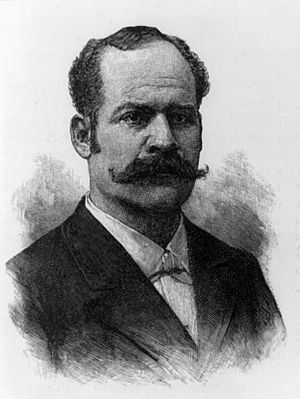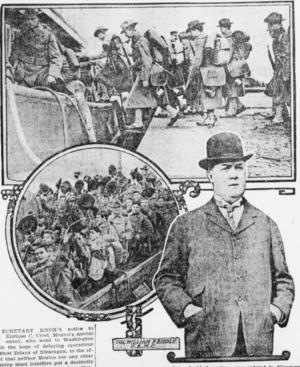José Santos Zelaya facts for kids
Quick facts for kids
Jose Santos Zelaya
|
|
|---|---|
 |
|
| President of Nicaragua | |
| In office 25 July 1893 – 21 December 1909 |
|
| Vice President | Anastasio J. Ortiz 1893–1894 Francisco Baca 1894–1896 |
| Preceded by | Joaquín Zavala (Acting) |
| Succeeded by | José Madriz (Acting) |
| Personal details | |
| Born |
José Santos Zelaya López
1 November 1853 Managua, Nicaragua |
| Died | 17 May 1919 (aged 65) New York City, U.S. |
| Political party | Democratic Party |
José Santos Zelaya López (1 November 1853 in Managua – 17 May 1919 in New York City) was the President of Nicaragua from 25 July 1893 to 21 December 1909.
Early life
He was a son of José María Zelaya Irigoyen, who was originally from Olancho, Honduras, and his mistress Juana López Ramírez. His father José María was married to Rosario Fernández.
Politics
Zelaya was of Nicaragua's Liberal party and enacted a number of progressive programs, including improved public education, railroads, and established steam ship lines. He also enacted constitutional rights that provided for equal rights, property guarantees, habeas corpus, compulsory vote, compulsory education, the protection of arts and industry, minority representation, and the separation of state powers. However, his desire for national sovereignty often led him to policies contrary to foreign investors.
In 1894, he took control of the Mosquito Coast by military force; it had long been the subject of dispute, and was home to a native settlement claimed as a protectorate by the British Empire. Indeed, Nicaragua (and before that Spain) had always claimed the Caribbean Coast, but "Zambos" pirates (former African runaway slaves mixed with local Indians) and part of the Misquito Indians (probably with the Sumos and Ramas as well), together with the military support of the British Marines, tried to create a free, English-speaking settlement under British protection. (Greytown, nowadays Puerto Zelaya). This is similar to the cases of Belize and Guatemala, except that Belize has been an independent nation since 1981. Zelaya's aggressive attitude paid off, and the United Kingdom, which probably did not wish to go to war over this distant land, recognized Nicaraguan seizure of the area. The strategic value of this land led to the name "Vía del Tránsito" ("Route of Traffic"). Both the United Kingdom and the USA wanted the control of this route, which connected the Caribbean Sea to the Pacific Coast across the San Juan River and Lake Nicaragua. At this point, the Panama Canal did not exist, and the USA was rising as a new continental power.
US sets up base of operations in Nicaragua
Officers of Zelaya's government executed some captured rebels; two United States volunteers were among them, and the U.S. government declared their execution grounds for a diplomatic break between the countries which later led to formal intervention. At the start of December, United States Marines landed in Nicaragua's Bluefields port, to create a neutral zone to protect foreign lives and property but which also acted as a base of operations for the anti-Zelayan rebels. On 17 December 1909, Zelaya turned over power to José Madriz and fled to Spain. Madriz called for continued suppression of the uprising, but in August 1910 diplomat Thomas Dawson obtained the capitulation of the government and the withdrawal of Madriz. Thereafter the U.S. called for a popular voice in the government and a constituent assembly was called to write a constitution for Nicaragua. The vacant presidency was filled by a series of Conservative politicians including Adolfo Diaz. During this time, through free trade and loans, the U.S. influenced the expanding prosperity and development of the country.
Family
His son, named after the King of Spain, was pianist Don Alfonso Zelaya. He was educated in Europe before his father sent him to America to pursue a military career. He was a graduate of West Point, 1910, and served four years in the U.S. Army, including the World War I years. In 1911 he married his first wife, American-born Marguerite Lee, grandniece of General Robert E. Lee. They had a son they named José Santos.
As a pianist he played with the San Francisco and Minneapolis symphony orchestras. With a repertoire of 300 classical pieces, his performances were not limited to the concert stage, for he also enjoyed bringing classical music to the vaudeville (Keith-Orpheum Circuit) stage. According to the Spokane (Washington) Spokesman-Review (Mar. 4, 1932): "...what is unique about this most affable and rotund Castilian is that he plays classical music and makes vaudeville audiences like it. He has a certain humor, a philosophical way of presenting his music that makes his audiences clamor for more and more."
Beginning in 1933 he made sporadic film appearances playing bit parts. He is best known today as the Mexican who gives involved and incomprehensible Spanish-language directions to the Three Stooges in their 1942 short, “What’s the Matador?” His last role was as "Gimpy," the piano player in Macao (1952). He died in North Hollywood on December 14, 1951.
See also
 In Spanish: José Santos Zelaya para niños
In Spanish: José Santos Zelaya para niños


